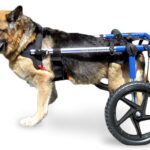Gabapentin, a medication originally developed for humans, has found its place in veterinary medicine as an effective treatment for pain, seizures, and anxiety in dogs. When prescribed by a veterinarian, Gabapentin can provide relief for dogs suffering from chronic pain, nerve-related conditions, or other health issues. However, proper dosing is essential for safety and effectiveness. This article explores the benefits, uses, and a dosage chart to help pet owners understand how Gabapentin is administered to dogs.
What is Gabapentin?
Gabapentin is an anticonvulsant and analgesic medication. In dogs, it is most commonly used to treat:
- Chronic pain, especially from nerve damage or arthritis.
- Seizures as part of a comprehensive treatment plan.
- Anxiety in certain cases, such as during travel or stressful situations.
Gabapentin works by altering how nerves communicate pain signals to the brain, providing relief to your furry friend.
Gabapentin Dosage for Dogs
The correct dosage of Gabapentin for dogs depends on several factors, including the dog’s weight, the condition being treated, and the veterinarian’s prescription. Below is a general dosage chart based on weight:
| Dog’s Weight (kg) | Gabapentin Dosage (mg) |
|---|---|
| 1–5 kg | 10–50 mg |
| 6–10 kg | 50–100 mg |
| 11–20 kg | 100–200 mg |
| 21–30 kg | 200–300 mg |
| 31–40 kg | 300–400 mg |
| 41+ kg | 400–600 mg |
Important Notes:
- The chart provides general guidelines. Always consult a veterinarian before administering Gabapentin.
- Dosage frequency is typically every 8–12 hours, depending on the condition being treated.
- Gabapentin is available in various forms, including capsules, tablets, and liquid.
Uses of Gabapentin in Dogs
- Pain Management
Gabapentin is often prescribed for managing pain caused by arthritis, cancer, or nerve damage. It is particularly effective in managing neuropathic pain. - Seizure Control
As an adjunct therapy, Gabapentin helps control seizures in dogs with epilepsy, improving their quality of life. - Anxiety Relief
Gabapentin may be used to calm dogs experiencing anxiety during specific situations, such as vet visits or travel.
Side Effects of Gabapentin
Gabapentin is generally well-tolerated by dogs, but some may experience side effects, including:
- Sedation or drowsiness.
- Mild ataxia (loss of coordination).
- Gastrointestinal issues like vomiting or diarrhea.
These side effects are usually temporary and subside as the dog’s body adjusts to the medication. If side effects persist, consult your veterinarian.
Precautions When Using Gabapentin
- Avoid Human Formulations Containing Xylitol: Gabapentin in liquid form for humans may contain xylitol, which is toxic to dogs.
- Gradual Dose Adjustment: If the treatment needs to be discontinued, the dosage should be tapered gradually to avoid withdrawal symptoms.
- Inform the Vet of Other Medications: Gabapentin may interact with other drugs, such as antacids or opioids. Ensure the veterinarian is aware of all medications your dog is taking.
Conclusion
Gabapentin can be a game-changer for dogs suffering from chronic pain, seizures, or anxiety. While it is effective, responsible use and adherence to the prescribed dosage are crucial. Always consult a qualified veterinarian for personalized guidance and follow their recommendations closely.
By understanding the uses, benefits, and dosage guidelines, you can help ensure your furry companion lives a more comfortable and happy life.



